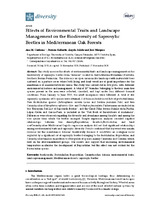Mostrar el registro sencillo del ítem
Effects of Environmental Traits and Landscape Management on the Biodiversity of Saproxylic Beetles in Mediterranean Oak Forests
| dc.contributor.author | Cárdenas, Ana M. | |
| dc.contributor.author | Gallardo de la Torre, Patricia | |
| dc.contributor.author | Salido, Ángela | |
| dc.contributor.author | Márquez, José | |
| dc.date.accessioned | 2020-11-30T09:38:59Z | |
| dc.date.available | 2020-11-30T09:38:59Z | |
| dc.date.issued | 2020 | |
| dc.identifier.uri | http://hdl.handle.net/10396/20845 | |
| dc.description.abstract | This study assesses the effects of environmental traits and landscape management on the biodiversity of saproxylic beetles from “dehesas” located in Sierra Morena Mountains (Córdoba, Southern Iberian Peninsula). The dehesa is an open savanna-like landscape with mature/old trees scattered on a pasture cover where both living and dead wood are of great importance for the maintenance of macroinvertebrate fauna. The study was carried out in five plots, with different environmental features and management. A total of 137 branches belonging to the four main tree species present in the area were collected, classified, and kept under four different thermal conditions. From January to June 2019, the adult emergences were followed. A total of 466 saproxylic specimens of 31 species were obtained, 5 of them included in red lists of protected fauna. Two Bostrichidae species (Lichenophanes numida Lesne and Scobicia pustulata Fab.) and two Cerambycidae (Chlorophorus ruficornis Oliv. and Trichoferus fasciculatus Faldermann) are included in the “European Red List of Saproxylic Beetles”; and the Clerid Tillus ibericus Bahillo de la Puebla, López–Colón and García–Paris, is included in the “Red Book of Invertebrate of Andalucía”. Differences were observed regarding the diversity and abundance among the plots and among the tree species from which the beetles emerged. Simple regression analyses revealed negative relationships between tree density/Buprestidae, livestock/Bostrichidae, and land use/Cerambycidae. Multivariant logistic regression analysis did not find significant relationships among environmental traits and saproxylic diversity. Results confirmed that dry wood was a main resource for the maintenance dehesas’ biodiversity because it constitutes an ecological niche exploited by a significant set of saproxylic beetles belonging to the Bostrichidae, Buprestidae, and Cerambycidae families, in addition to other guilds of species, mainly Carabidae and Cleridae, which feed on the above-mentioned groups. Our results also support that increasing environmental temperature accelerates the development of Buprestidae, but this effect was not evident for the Bostrichidae species. | es_ES |
| dc.format.mimetype | application/pdf | es_ES |
| dc.language.iso | eng | es_ES |
| dc.publisher | MDPI | es_ES |
| dc.rights | https://creativecommons.org/licenses/by/4.0/ | es_ES |
| dc.source | Diversity 12(12), 451 (2020) | es_ES |
| dc.subject | Biodiversity | es_ES |
| dc.subject | Bostrichidae | es_ES |
| dc.subject | Buprestidae | es_ES |
| dc.subject | Cerambycidae | es_ES |
| dc.subject | Dehesas | es_ES |
| dc.subject | Environmental traits | es_ES |
| dc.subject | Landscape management | es_ES |
| dc.subject | Mediterranean forests | es_ES |
| dc.subject | Saproxylic beetles | es_ES |
| dc.title | Effects of Environmental Traits and Landscape Management on the Biodiversity of Saproxylic Beetles in Mediterranean Oak Forests | es_ES |
| dc.type | info:eu-repo/semantics/article | es_ES |
| dc.relation.publisherversion | http://dx.doi.org/10.3390/d12120451 | es_ES |
| dc.rights.accessRights | info:eu-repo/semantics/openAccess | es_ES |

